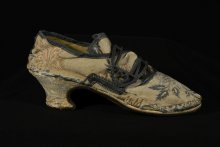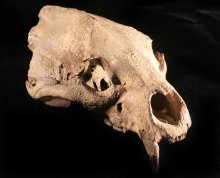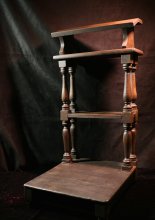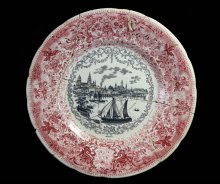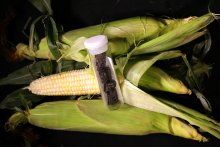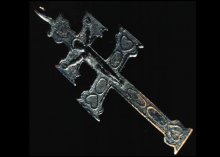Colonial Outpost (1673-1776)
Jacques Marquette and Louis Joliet explored Illinois in 1673, extending the reach of New France in America. Eager to earn rich profits through trading with Native Americans, to convert Indians to Christianity, and to establish and maintain their claim to the region, France dominated the Mississippi Valley for almost a century. French influence diminished when they were defeated by the British in 1763. Afterwards, many Native American tribes joined the British during the American Revolution in hopes of stemming the expansion of American settlement.
These shoes were passed down through six generations of an Illinois family. They were worn by the donor’s great-great-grandmother, Joahanna Herrick of Massachusetts, when she married William Bartlett at age 16 in 1761.
Even a piece of bone adapted for use as a tool is an opportunity for artistic expression. In this case, an arrow straightener, made from a bison’s rib bone, serves as a tiny canvas. It was found at the Kaskaskia Village site in Randolph County and collected in 1952.
Like other large carnivores, the Black Bear (Ursus americanus) was gone from Illinois by the mid to late 1800s. Queto (Luella) J. Rennier of Champaign found this Black Bear cranium in the Embarras River in Jasper County and donated it to the Illinois State Museum in 2012. One of the bear’s teeth was sampled in order to obtain an age. The bear dates to about A.D. 1760, or 250 years before present, just before the American Revolutionary War and the signing of the Declaration of Independence.
The Kirtland’s Water Snake shares some similar habitats and habits as the Massasauga Rattlesnake and is also under scrutiny as its numbers continue to decline. It is not venomous, but it uses crayfish burrows like the Massasauga and spends most of its life underground. Biologists hoping to survey the secretive snake often will use a cover board, a corrugated sheet of aluminum that is placed over a crayfish burrow.
This prie dieu, or prayer kneeler, was used by French settlers in the Illinois territory during the late 18th century. During prayer, individuals would kneel on the bottom platform and rest their elbows or place books on the upper shelf. The Roman Catholic Church played a dominant role in the lives of these settlers, who celebrated 27 religious holidays throughout the year.
Immigrating to a new land brought with it plenty of uncertainty. That may be why a German immigrant family brought items with them that reminded them of home. This transfer print plate, made in the style of Staffordshire, England potters, was actually made by Villeroy & Boch, a German pottery firm.
A harbinger of a changing world. French explorers and voyageurs arrive in the late 17th century. Their presence will transform Native American life and foretell of even more profound change to come. The forces of colonization nearly extinguish Native American life in Illinois.






